Comparing the Mentalities
Using a Typology-Essences Table
The TET permits us to look simultaneously at all seven approaches to ethical choice in an arrangement that reflects the basic mechanics of choice.
Step 1: Determine the TET Axes
In relation to the Interacting-for-Benefitframework:
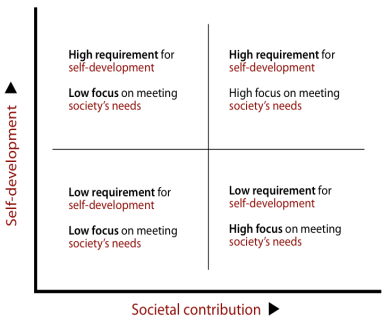
X-Axis: The social outcome is about contribution to society
e.g. How much does the mentality generate benefit in the social setting? How far are societal needs deliberately considered? Are social values important? Is there likely to be social growth or social development as a result?
How much does the mentality generate benefit in the social setting? How far are societal needs deliberately considered? Are social values important? Is there likely to be social growth or social development as a result?
Y-Axis: The psychological requirement relates to self-development
e.g. Does the inner world of self-awareness need attention to use the mentality? How far is personal growth deliberately considered and pursued?
Does the inner world of self-awareness need attention to use the mentality? How far is personal growth deliberately considered and pursued?
Step 2: Position the Mentalities
We will consider and plot approaches one by one on the blank TET with axes & quadrants labelled as shown:
high on both self-development and societal contribution (upper-right),
low on both self-development and societal contribution (lower-left),
high on self-development and low on societal contribution (upper-left), &
low on self-development and high on societal contribution (lower right).
Understanding why the mentalities are positioned as they are is important for further applications. So …
We start with the extreme mentalities:
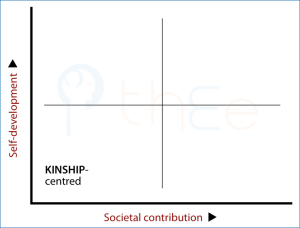
Y-Axis: Self development.Kinship values demand subjugation of the self to family wishes and the needs of other members. The family unit is of paramount concern. Tradition and family approval are often the authority for many personal decisions and life-choices. Relating to non-family is rejected. Self-initiated change is viewed as threatening. So it is necessarily very low on the Y Axis.
X-Axis: Societal contribution. At the same time, the intense inward orientation neglects society or even seeks to exploit it. There is often a deep distrust of government. In multi-racial societies, strong kinship attitudes and clan relationships promote ghetto formation, ethnic or tribal rivalry and quasi-paranoid attitudes to outsiders. So it is also very low the X-axis.
We place Kinship-centredness in the lower left corner of the lower left quadrant
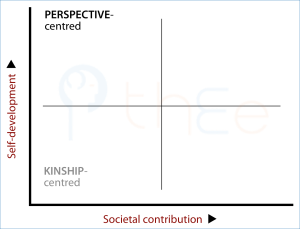
X-Axis: Societal contribution. This approach values learning for its own sake, welcomes diversity irrespective of its social impact and upholds a relativism that rejects the inherent superiority of those values and absolutes on which any society depends. This means it is very low on the X-axis.
Y-Axis: Self development. At the same time, a great deal is demanded of the self, because genuine appreciation and acceptance of new ideas and customs is personally challenging. It involves hard work in emotional, intellectual and social terms. So it is very high on the Y-Axis.
We place Perspective-centredness in the upper left corner of the upper left quadrant
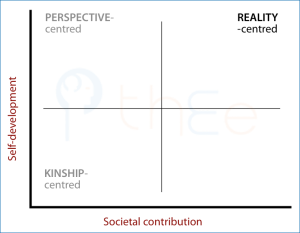
The position taken is that self-development and contributing to society are inextricably interlinked.
Y-Axis: Self development. Seeing dangers to society clearly, recognizing social potential, and communicating effectively, all depend on imagination that requires the most disciplined cultivation of the self. Spiritual awareness and its conscious use without arrogance also requires personal effort. So it is very high on the Y-axis.
X-Axis: Societal contribution.. The mentality also accepts responsibility for others and for wider society more generally. Indeed, the whole of humanity is considered, but there is also an overt recognition of the need to conform to the established order and work from where people are. The most socially beneficial contributions probably stem from reducing hostility through unification of conflicting forces and harmonization of disparate ideas. So it is very high on the X-axis.
We place Reality-centredness in the upper right corner of the upper right quadrant
We now turn to the central mentalities:
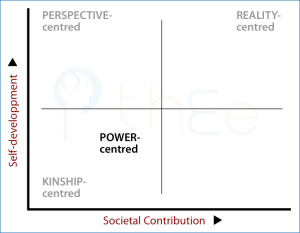
X-Axis: Societal contribution. From politicians, investment bankers and many bureaucrats, we note that the orientation is more about manipulating the social system for personal gain than serving it. A rather limited concern for society goes along with a contempt for those being dominated and exploited. Nevertheless, to gain that status, respect, control, salary and numerous perks, some quantum of benefit to society must always be provided. We therefore rate it low on the X-Axis, but not extremely so.
Y-Axis: Self development. To use power, some self-knowledge is required—both to find one’s position in the pecking order and to avoid being harmed. However, the self is not immune from being exploited and harmed by its own mentality (e.g. via heroism, drinking, sexuality, impulsive acts, vendettas, &c.) In addition, the lack of principles, preparedness to alter attitudes to get on the winning side, and rejection of rational thought, imply identity diffusion. Altogether, this means Power-centredness must be rated low on the Y-Axis, even if not at the extreme.
We place Power-centredness in the upper right part of the lower left quadrant.
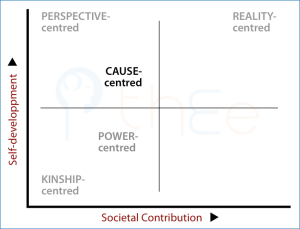
X-Axis: Societal contribution. There is a focus on ideals and ideology, invariably linked to society’s concerns—professional, scientific, religious, communal or political. There are often efforts to generate social improvements, but adherents exaggerate the importance of their cause. They may demand massive social readjustments, unrealistic reallocation of resources, and sometimes abandonment of much that is valued or even essential in society. So Cause-centredness must be rated low on the X-Axis, but not as low as Kinship- or Perspective-centredness.
Y-Axis: Self development. Causes demand development of genuine convictions and identification, and this requires reflection and study. The required commitment then shapes identity and may influence personal choices including marriage, family-life, vocation or career. Although it can be rated high on the Y-Axis, a lack of balance and the acquiescence to given rules and beliefs limits focus and the realization of personal potential.
We place Cause-centredness in the lower right part of the upper left quadrant.
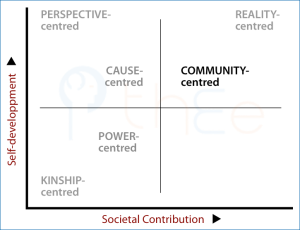
X-Axis: Societal contribution. This approach is built around the generation of social improvements. However, it is limited by a concern for communal integration, for fairness, for tolerance and for democracy. This makes it worthy and places it high on the X-Axis, but not at the extreme.
Y-Axis: Self development. Self-development is required to sense social needs, to handle people and to enable cooperation. Appreciation of the feelings, interests and intentions essential to find a consensus puts demands on the self that can only be met by a positive focus on self-awareness and self-development. This places it high on the Y-Axis, and in the upper-right quadrant with Reality-centredness but, again, not at the extreme.
We place Community-centredness in the lower left part of the upper right quadrant.
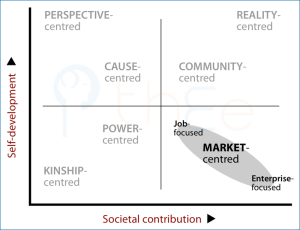
This differs from the others in that it exists in both more and less extreme forms, extending diffusely through the lower-right quadrant (as shown by the shaded diagonal ellipse in the diagram).
X-Axis: Societal contribution. Market-based activity—business enterprise—is intrinsic to social development because production, competition and consumption are the cornerstones of the prosperous society that all desire. So such a mentality is intrinsically high to very high on the X-Axis.
Y-Axis: Self development. However, competition to make money in markets is a hard taskmaster. It depends far more on character than personal growth. Inherent talent, persistent effort, social support and opportunity are the main factors in success: so the mentality varies from very low to low on the Y-Axis.
There is an «extreme» and a «central» version of the market-centred mentality.
At one extreme of the Market-centred approach are entrepreneurs who are … socially responsive individuals seeking opportunities to establish new enterprises and competing for customers. Successful enterprises are a boon to society because they generate salaried jobs and wealth in the form of desirable goods and services. In pursuing profits, entrepreneurs subordinate personal preferences and self-development concerns to business needs. We can label this version of market-centredness as enterprise-focused and locate it at the extreme lower right of the lower right quadrant.
socially responsive individuals seeking opportunities to establish new enterprises and competing for customers. Successful enterprises are a boon to society because they generate salaried jobs and wealth in the form of desirable goods and services. In pursuing profits, entrepreneurs subordinate personal preferences and self-development concerns to business needs. We can label this version of market-centredness as enterprise-focused and locate it at the extreme lower right of the lower right quadrant.
Similarly Market-centred, but very different, are those many employees and managers who compete for jobs and promotions in firms … so they can get ahead and better themselves. Such people recognize the importance of profit to the company and see their contribution in those terms. However, they apply their talents best when their own interests and preferences are properly met and this calls for a greater focus on self-knowledge and self-development. We can label this version of market-centredness as job-focused, and it must be positioned more centrally in the upper left of the lower right quadrant.
so they can get ahead and better themselves. Such people recognize the importance of profit to the company and see their contribution in those terms. However, they apply their talents best when their own interests and preferences are properly met and this calls for a greater focus on self-knowledge and self-development. We can label this version of market-centredness as job-focused, and it must be positioned more centrally in the upper left of the lower right quadrant.
We show the Market-centred approach covering a diffuse elliptical area in the lower right quadrant.
 «The Producer»
«The Producer»
Many people in the labour market, perhaps even the majority, are not Market-centred at all. Their primary mentality lies elsewhere. So they may prefer to work in the public or voluntary sectors where there are some pressures for efficiency and value for money, but profit is not an issue.
The deep preoccupation for many employees, including those working hard within businesses, is to produce (or service) and get paid for producing (or servicing).
It is natural and good that people desire to benefit from doing what they are currently doing and enjoy doing: but this is the «producer-mentality. Sadly, it is not viable in the realm of prospering. On close inspection of any particular person, the mentality turns out to be one or more of:
- Cause-centred: i.e. the person’s occupation or activity is their cause;
- Power-centred: i.e. the person bands with other «producers» to have clout;
- Kinship-centred: i.e. the activity is based in custom or family tradition;
- Weakly Market-centred with someone else expected to market the producer's service/product.
Confused?
If you are puzzled by the positioning of any mentality, then you should either:
- Think it through with me in the next section.
- Post queries.
- Discuss with other users.
Originally posted: July 2009

 Reality-centred
Reality-centred






